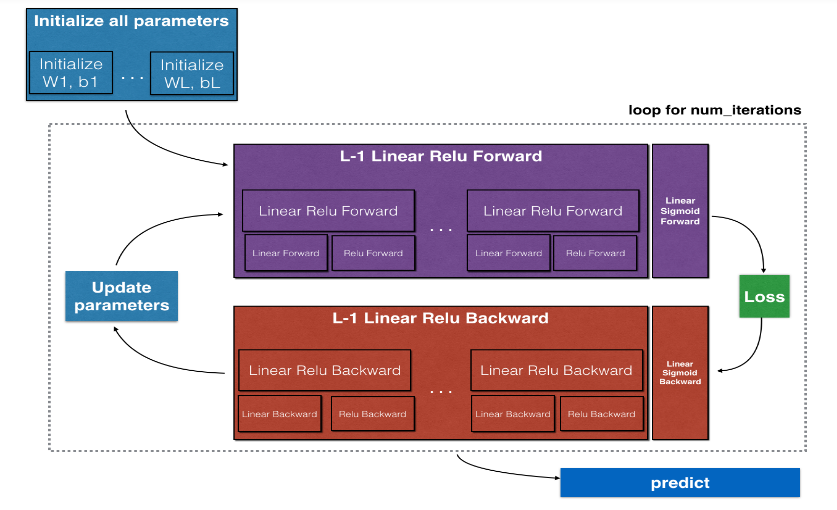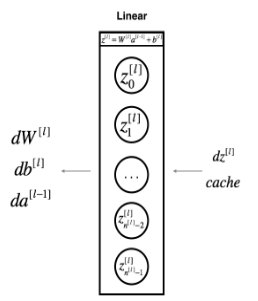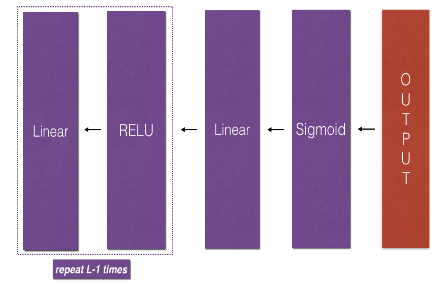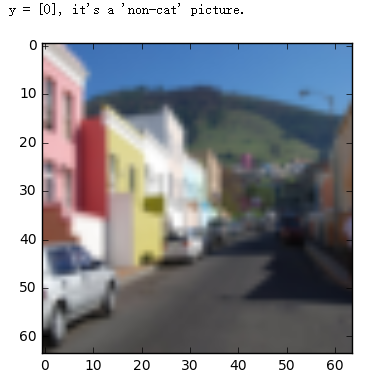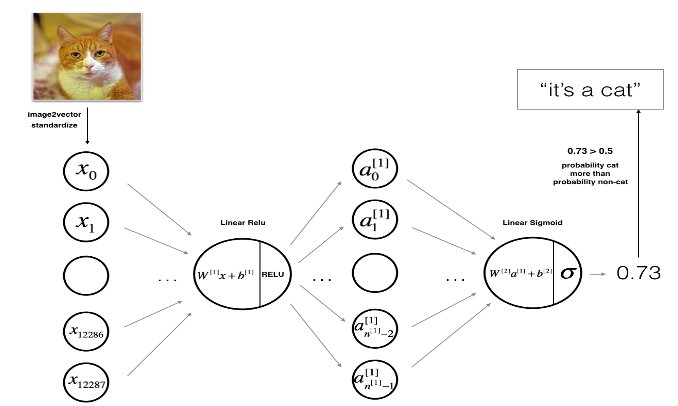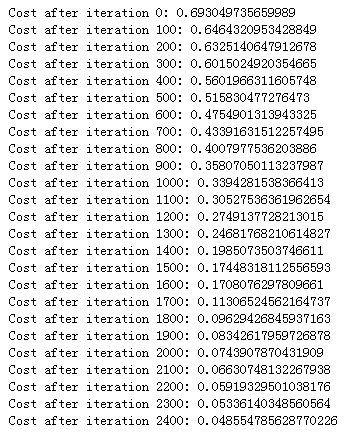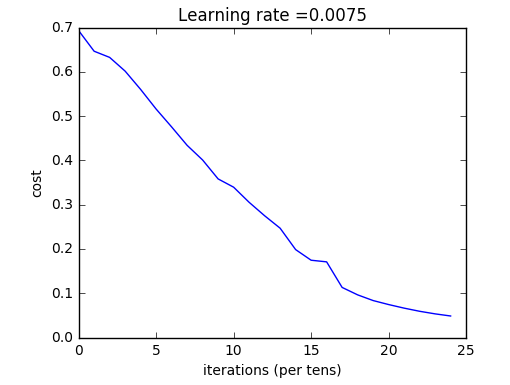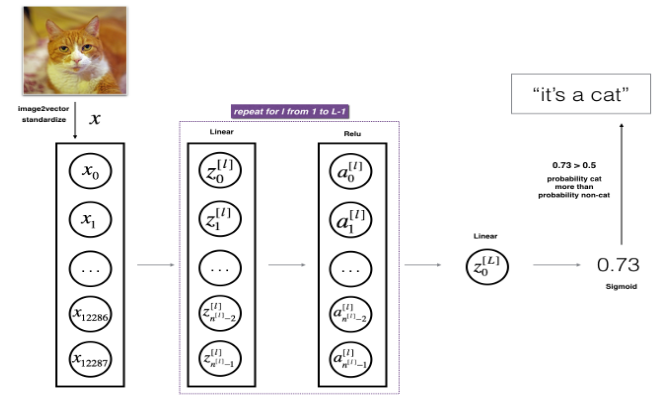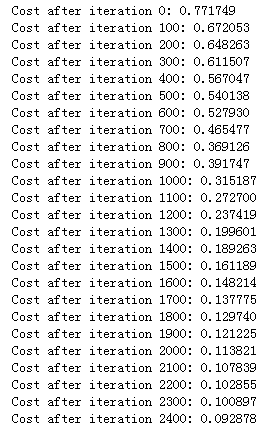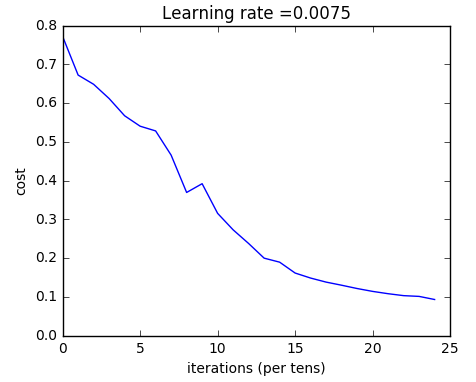第一部分:基本架构 这是深度学习专项课程第一课第四周的编程作业的第一部分,通过这一部分,可以学到:
使用非线性单元比如 ReLU 来提高模型
建立一个更深的神经网络(大于一个隐藏层)
实现一个易用的神经网络类
包的引入 1 2 3 4 5 6 7 8 9 10 11 12 13 14 import numpy as npimport h5py import matplotlib.pyplot as pltfrom testCases_v4 import *from dnn_utils_v2 import sigmoid, sigmoid_backward, relu, relu_backward%matplotlib inline plt.rcParams['figure.figsize' ] = (5.0 , 4.0 ) plt.rcParams['image.interpolation' ] = 'nearest' plt.rcParams['image.cmap' ] = 'gray' %load_ext autoreload %autoreload 2
总体框架
初始化一个两层神经网络的参数以及一个 L 层的神经网络的参数
实现前向传播模块(下图中的紫色模块)
实现某一层的前向传播步骤的线性部分 (得到 $Z^{[l]}$)
给定激活函数(relu/sigmoid)
组合之前的两步形成一个[线性—>激活] 前向传播函数
重复[线性—>ReLU] 前向传播函数 L-1 次(对于 1 到 L-1 层),再加上[线性—>sigmoid] 在末尾(对于二元分类的最终层 L)。这形成了一个新的 L_model_forward 函数
计算损失函数
实现反向传播模块(下图中的红色部分)
计算某一层的反向传播函数步骤的线性部分
计算激活函数的梯度(relu_backward/sigmoid_backward)
组合之前的两步形成一个新的[线性—>激活] 反向传播函数
重复[线性—>relu] 反向传播 L-1 次,然后加上[线性—>sigmoid] 反向传播在末尾。这形成了一个新的 L_model_backward 函数
更新参数
初始化 两层神经网路初始化
模型结构为:LINEAR -> RELU -> LINEAR -> SIGMOID
权重 W 采用随机初始化
偏差 b 采用初始化为零的方法
1 2 3 4 5 6 7 8 9 10 11 12 13 14 15 16 17 18 19 20 21 22 23 24 25 26 27 28 29 30 31 def initialize_parameters (n_x, n_h, n_y) : """ Argument: n_x -- size of the input layer n_h -- size of the hidden layer n_y -- size of the output layer Returns: parameters -- python dictionary containing your parameters: W1 -- weight matrix of shape (n_h, n_x) b1 -- bias vector of shape (n_h, 1) W2 -- weight matrix of shape (n_y, n_h) b2 -- bias vector of shape (n_y, 1) """ W1 = np.random.randn(n_h,n_x)*0.01 b1 = np.zeros((n_h,1 )) W2 = np.random.randn(n_y,n_h)*0.01 b2 = np.zeros((n_y,1 )) assert (W1.shape == (n_h, n_x)) assert (b1.shape == (n_h, 1 )) assert (W2.shape == (n_y, n_h)) assert (b2.shape == (n_y, 1 )) parameters = {"W1" : W1, "b1" : b1, "W2" : W2, "b2" : b2} return parameters
L 层的神经网络的初始化 假设输入 X 维度是(12288,209),则其他的维度如下:
模型结构为:[LINEAR -> RELU] × (L-1) -> LINEAR -> SIGMOID
权重 W 采用随机初始化
偏差 b 采用初始化为零
将每层单元个数储存在 list 变量 layer_dims 里面
1 2 3 4 5 6 7 8 9 10 11 12 13 14 15 16 17 18 19 20 21 22 23 24 def initialize_parameters_deep (layer_dims) : """ Arguments: layer_dims -- 包含每一层的维度数据的list数组 Returns: parameters -- python dictionary containing your parameters "W1", "b1", ..., "WL", "bL": Wl -- weight matrix of shape (layer_dims[l], layer_dims[l-1]) bl -- bias vector of shape (layer_dims[l], 1) """ parameters = {} L = len(layer_dims) for l in range(1 , L): parameters['W' + str(l)] = np.random.randn(layer_dims[l],layer_dims[l-1 ])*0.01 parameters['b' + str(l)] = np.zeros((layer_dims[l],1 )) assert (parameters['W' + str(l)].shape == (layer_dims[l], layer_dims[l-1 ])) assert (parameters['b' + str(l)].shape == (layer_dims[l], 1 )) return parameters
前向传播模块
线性前向传播
线性—>激活前向传播,其中激活函数可以是 ReLU 或者 sigmoid
整个模型为:[线性 —> relu] ×(L-1)—> 线性 —> sigmoid
线性前向传播
输入上一层的激活值 A_prev,这一层的参数 W,b,
输出这一层的线性值 Z 和 “线性缓存”
“线性缓存”是一个值为 (A_prev,W,b) 的 tuple
$Z^{[l]} = W^{[l]}A^{[l-1]} +b^{[l]}$
1 2 3 4 5 6 7 8 9 10 11 12 13 14 15 16 17 18 19 20 def linear_forward (A_prev, W, b) : """ Arguments: A_prev -- 之前层的激活值 (或输入数据): (size of previous layer, number of examples) W -- 权重矩阵: numpy array of shape (size of current layer, size of previous layer) b -- 偏差向量, numpy array of shape (size of the current layer, 1) Returns: Z -- 这一层激活函数的输入值,也叫“前激活”参数 cache -- “线性缓存”,值为 (A_prev,W,b) 的 tuple,可以更有效率地计算反向传播 """ Z = np.dot(W,A_prev) + b assert (Z.shape == (W.shape[0 ], A_prev.shape[1 ])) cache = (A_prev, W, b) return Z, cache
一层线性-激活前向传播
输入上一层的激活值 A_prev,这一层的参数 W 和 b,以及激活函数名 (字符串)
输出这一层的激活值 A 和 “前向传播缓存”
“前向传播缓存” = “线性缓存”(A_prev,W,b) + “激活缓存”Z,是一个值为 ( (A_prev,W,b), Z) 的 tuple,简称“缓存”
$A^{[l]} = g(Z^{[l]}) = g(W^{[l]}A^{[l-1]} +b^{[l]})$
1 2 3 4 5 6 7 8 9 10 11 12 13 14 15 16 17 18 19 20 21 22 23 24 25 26 27 def linear_activation_forward (A_prev, W, b, activation) : """ Arguments: A_prev -- 之前层的激活值 (或输入数据): (size of previous layer, number of examples) W -- 权重矩阵: numpy array of shape (size of current layer, size of previous layer) b -- 偏差向量, numpy array of shape (size of the current layer, 1) activation -- 在这一层用到的激活函数, 用字符串储存: "sigmoid" 或 "relu" Returns: A -- 这一层的激活值 cache -- 前向传播缓存,是一个包含 "linear_cache"(线性缓存,A_prev,W,b) 和 "activation_cache"(激活缓存,Z) 的 tuple:((A_prev,W,b),Z) """ if activation == "sigmoid" : Z, linear_cache = linear_forward(A_prev,W,b) A, activation_cache = sigmoid(Z) elif activation == "relu" : Z, linear_cache = linear_forward(A_prev,W,b) A, activation_cache = relu(Z) assert (A.shape == (W.shape[0 ], A_prev.shape[1 ])) cache = (linear_cache, activation_cache) return A, cache
其中:
1 2 3 4 5 6 7 8 9 10 11 12 13 14 15 16 def sigmoid (Z) : A = 1 /(1 +np.exp(-Z)) cache = Z return A, cache def relu (Z) : A = np.maximum(0 ,Z) assert (A.shape == Z.shape) cache = Z return A, cache
L 层模型的前向传播 对于二元分类,先 [线性-relu激活] L-1 次,再 [线性-sigmoid激活] 一次
1 2 3 4 5 6 7 8 9 10 11 12 13 14 15 16 17 18 19 20 21 22 23 24 25 26 27 28 29 30 31 32 def L_model_forward (X, parameters) : """ Implement forward propagation for the [LINEAR->RELU]*(L-1)->LINEAR->SIGMOID computation Arguments: X -- 初始训练集, numpy array of shape (input size, number of examples) parameters -- 初始化函数 initialize_parameters_deep() 输出的初始化之后的参数 Returns: AL -- 最终层即 L 层的激活值 caches -- 包含每一层"前向传播缓存"的 list (一共有 L-1 个, 索引值为 0 到 L-1) 其中每一层的缓存是一个 tuple:((A,W,b),Z) """ caches = [] A = X L = len(parameters) // 2 for l in range(1 , L): A_prev = A A, cache = linear_activation_forward(A_prev, parameters['W' + str(l)], parameters['b' + str(l)], 'relu' ) caches.append(cache) AL, cache = linear_activation_forward(A, parameters['W' + str(L)], parameters['b' + str(L)], 'sigmoid' ) caches.append(cache) assert (AL.shape == (1 ,X.shape[1 ])) return AL, caches
关于缓存,在对输入进行线性运算时,生成“线性缓存” ,是一个 (A_prev,W,b) 的 tuple,在对线性值进行激活运算时,生成“激活缓存” ,是一个值为 Z 的数组,在进行 [线性-激活] 的前向传播时,生成的是“前向传播缓存” ,简称“缓存” ,是一个值为 ((A_prev,W,b),Z) 的 tuple
计算代价函数 1 2 3 4 5 6 7 8 9 10 11 def compute_cost (AL, Y) : m = Y.shape[1 ] cost = -1 /m * ( np.dot(Y, np.log(AL).T) + np.dot((1 -Y), np.log(1 -AL).T) ) cost = np.squeeze(cost) assert (cost.shape == ()) return cost
反向传播模块
线性反向传播
线性—>激活反向传播,其中“激活”计算 relu 或者 sigmoid 函数的梯度
整个模型为:[线性 —> relu] ×(L-1)—> 线性 —> sigmoid
线性反向传播 已知 $dZ^{[l]} = \frac{\partial \mathcal{L} }{\partial Z^{[l]}}$ 和该层 “线性缓存”(A_prev,W,b),求 $dW^{[l]}, db^{[l]} ,dA^{[l-1]}$ ,如下图所示
计算公式为:
1 2 3 4 5 6 7 8 9 10 11 12 13 14 15 16 17 18 19 20 21 22 23 24 25 def linear_backward (dZ, cache) : """ Arguments: dZ -- 代价函数对某l层线性输出 Z 的偏导 (of current layer l) cache -- 该l层的前向传播“线性缓存” tuple:(A_prev, W, b) Returns: dA_prev -- 代价函数对前一层 l-1 层的激活值的偏导数,与 A_prev 的形状相同 dW -- 代价函数对当前层 l 层的权重 W 的偏导数,形状与 W 相同 db -- 代价函数对当前层 l 层的偏差 b 的偏导数,形状与 b 相同 """ A_prev, W, b = cache m = A_prev.shape[1 ] dW = 1 /m * np.dot(dZ, A_prev.T) db = 1 /m * np.sum(dZ, axis=1 , keepdims=True ) dA_prev = np.dot(W.T, dZ) assert (dA_prev.shape == A_prev.shape) assert (dW.shape == W.shape) assert (db.shape == b.shape) return dA_prev, dW, db
一层线性-激活反向传播
已知 $dA^{[l]} = \frac{\partial \mathcal{L} }{\partial A^{[l]}}$ 和 $g(.)$ 和该层 “前向传播缓存”((A_prev,W,b),Z),先求 $dZ^{[l]}$, 再求 $dW^{[l]}, db^{[l]} ,dA^{[l-1]}$
$dZ^{[l]} = dA^{[l]} * g’(Z^{[l]})$
1 2 3 4 5 6 7 8 9 10 11 12 13 14 15 16 17 18 19 20 21 22 23 24 def linear_activation_backward (dA, cache, activation) : """ Arguments: dA -- 当前层l层的激活值梯度 cache -- “前向传播缓存”tuple:((A_prev,W,b),Z) activation -- 在这一层用到的激活函数, 用字符串储存: "sigmoid" 或 "relu" Returns: dA_prev -- 代价函数对前一层 l-1 层的激活值的偏导数,与 A_prev 的形状相同 dW -- 代价函数对当前层 l 层的权重 W 的偏导数,形状与 W 相同 db -- 代价函数对当前层 l 层的偏差 b 的偏导数,形状与 b 相同 """ linear_cache, activation_cache = cache if activation == "relu" : dZ = relu_backward(dA, activation_cache) dA_prev, dW, db = linear_backward(dZ, linear_cache) elif activation == "sigmoid" : dZ = sigmoid_backward(dA, activation_cache) dA_prev, dW, db = linear_backward(dZ, linear_cache) return dA_prev, dW, db
其中 dA 求得 dZ 的函数如下:
1 2 3 4 5 6 7 8 9 10 11 12 13 14 15 16 17 18 19 20 21 22 23 24 25 26 27 28 29 30 31 32 def relu_backward (dA, cache) : """ 实现单个 relu 单元的反向传播 Arguments: dA -- 某l层的激活值 cache -- 该层的“激活缓存” Z Returns: dZ -- 代价函数对l层的 Z 的梯度 """ Z = cache dZ = np.array(dA, copy=True ) dZ[Z <= 0 ] = 0 assert (dZ.shape == Z.shape) return dZ def sigmoid_backward (dA, cache) : Z = cache s = 1 /(1 +np.exp(-Z)) dZ = dA * s * (1 -s) assert (dZ.shape == Z.shape) return dZ
L 层模型的反向传播 对于二元分类,先 [sigmoid—>线性] 一次,再 [relu—>线性] L-1 次
反向传播初始化,即求 dAL 可以使用公式:$dAL=-\frac{Y}{AL}-\frac{1-Y}{1-AL}$
将梯度数据存入名为 grads 的 dict 中:$grads[“dW” + str(l)] = dW^{[l]}$
1 2 3 4 5 6 7 8 9 10 11 12 13 14 15 16 17 18 19 20 21 22 23 24 25 26 27 28 29 30 31 32 33 34 35 36 37 38 39 def L_model_backward (AL, Y, caches) : """ Implement the backward propagation for the [LINEAR->RELU] * (L-1) -> LINEAR -> SIGMOID group Arguments: AL -- 前向传播的最终激活值向量 Y -- 真实的“标签”向量 (包含 0 if non-cat, 1 if cat) caches -- 总缓存,包含每一层的“前向传播缓存”,用 sigmoid 函数进行激活的缓存是 cache[L-1],用 relu 函数进行激活的缓存是 cache[l] (for l in range(L-1),即 l = 0,1...,L-2) Returns: grads -- 包含代价函数对 A,W,b 的梯度的 dict grads["dA" + str(l)] = ... grads["dW" + str(l)] = ... grads["db" + str(l)] = ... """ grads = {} L = len(caches) m = AL.shape[1 ] Y = Y.reshape(AL.shape) dAL = - (np.divide(Y, AL) - np.divide(1 - Y, 1 - AL)) current_cache = caches[L-1 ] grads["dA" + str(L-1 )], grads["dW" + str(L)], grads["db" + str(L)] = linear_activation_backward(dAL, current_cache, 'sigmoid' ) for l in reversed(range(L-1 )): current_cache = caches[l] dA_prev_temp, dW_temp, db_temp = linear_activation_backward(grads['dA' + str(L-1 )], current_cache, 'relu' ) grads["dA" + str(l)] = dA_prev_temp grads["dW" + str(l + 1 )] = dW_temp grads["db" + str(l + 1 )] = db_temp return grads
更新参数 1 2 3 4 5 6 7 8 9 10 11 12 13 14 15 16 17 18 19 20 21 22 def update_parameters (parameters, grads, learning_rate) : """ Arguments: parameters -- 包含所有初始化后的参数的字典 grads -- 包含所有参数的梯度的字典 learning_rate -- 学习率 Returns: parameters -- 包含所有更新过的参数的字典 parameters["W" + str(l)] = Wl 的值 parameters["b" + str(l)] = bl 的值 """ L = len(parameters) // 2 for l in range(L): parameters["W" + str(l+1 )] = parameters["W" + str(l+1 )] - learning_rate * grads["dW" + str(l+1 )] parameters["b" + str(l+1 )] = parameters["b" + str(l+1 )] - learning_rate * grads["db" + str(l+1 )] return parameters
第二部分:图片识别应用 这是深度学习专项课程第一课第四周的编程作业的第二部分,通过这一部分,可以学到:
学习如何使用第一部分中构建的辅助函数来建立我们需要的任何结构的模型
用不同的模型结构进行实验观察每一种的表现
认识到在从头开始构建神经网络之前构建辅助函数使得任务更加容易
包的引入 1 2 3 4 5 6 7 8 9 10 11 12 13 14 15 16 import timeimport numpy as npimport h5pyimport matplotlib.pyplot as pltimport scipyfrom PIL import Imagefrom scipy import ndimagefrom dnn_app_utils_v3 import *%matplotlib inline plt.rcParams['figure.figsize' ] = (5.0 , 4.0 ) plt.rcParams['image.interpolation' ] = 'nearest' plt.rcParams['image.cmap' ] = 'gray' %load_ext autoreload %autoreload 2
数据集 数据集包括:
m_train 个训练集,包括图片集 train_set_x_orig 和标签集 train_set_y
m_test 个测试集,包括图片集 test_set_x_orig 和标签集 test_set_y
每张图片都是方形 (height = num_px, width = num_px),有三个颜色通道,所以数组形状是 (num_px, num_px, 3)
每个图片集都要进行预处理,所以原始数据加上 _orig ,但是标签集不需要预处理
数据集预处理 加载原始数据集 1 2 train_set_x_orig, train_set_y, test_set_x_orig, test_set_y, classes = load_dataset()
1 2 3 4 5 index = 1 plt.imshow(train_set_x_orig[index]) print ("y = " + str(train_set_y[:, index]) + ", it's a '" + classes[np.squeeze(train_set_y[:, index])].decode("utf-8" ) + "' picture." )
确定图片维度和个数以防止出错
训练集的个数:m_train
测试集的个数:m_test
图片(正方形)的尺寸即边长的像素数:num_px
1 2 3 4 5 6 7 8 9 10 11 12 13 14 m_train = train_set_x_orig.shape[0 ] m_test = test_set_x_orig.shape[0 ] num_px = train_set_x_orig.shape[1 ] print ("Number of training examples: m_train = " + str(m_train))print ("Number of testing examples: m_test = " + str(m_test))print ("Height/Width of each image: num_px = " + str(num_px))print ("Each image is of size: (" + str(num_px) + ", " + str(num_px) + ", 3)" )print ("train_set_x shape: " + str(train_set_x_orig.shape))print ("train_set_y shape: " + str(train_set_y.shape))print ("test_set_x shape: " + str(test_set_x_orig.shape))print ("test_set_y shape: " + str(test_set_y.shape))
1 2 3 4 5 6 7 8 >>Number of training examples: m_train = 209 Number of testing examples: m_test = 50 Height/Width of each image: num_px = 64 Each image is of size: (64, 64, 3) train_set_x shape: (209, 64, 64, 3) train_set_y shape: (1, 209) test_set_x shape: (50, 64, 64, 3) test_set_y shape: (1, 50)
重构图片数组变为标准输入矩阵 把尺寸为 (num_px, num_px, 3) 的图片变为 shape 为 (num_px ∗ num_px ∗ 3, 1) 的向量
把一个 shape 为 (a,b,c,d) 的矩阵变为一个 shape 为 (b∗c∗d, a) 的矩阵的技巧:x_flatten = X.reshape(X.shape[0], -1).T
实际上,reshape() 是按行 取元素,按行 放元素
1 2 3 4 5 6 7 8 9 train_set_x_flatten = train_set_x_orig.reshape(train_set_x_orig.shape[0 ],-1 ).T test_set_x_flatten = test_set_x_orig.reshape(test_set_x_orig.shape[0 ],-1 ).T print ("train_set_x_flatten shape: " + str(train_set_x_flatten.shape))print ("train_set_y shape: " + str(train_set_y.shape))print ("test_set_x_flatten shape: " + str(test_set_x_flatten.shape))print ("test_set_y shape: " + str(test_set_y.shape))print ("sanity check after reshaping: " + str(train_set_x_flatten[0 :5 ,0 ]))
1 2 3 4 5 >>train_set_x_flatten shape: (12288, 209) train_set_y shape: (1, 209) test_set_x_flatten shape: (12288, 50) test_set_y shape: (1, 50) sanity check after reshaping: [17 31 56 22 33]
数据标准化 为了使得数据在一个合适的尺度上,我们需要将数据标准化,对于图片来说,由于图片的每个像素的 RGB 值介于 0 到 255 之间,所以我们可以将每个特征值除以 255,这样就能将它们标准化了
1 2 3 train_set_x = train_set_x_flatten/255. test_set_x = test_set_x_flatten/255.
一般方法
初始化参数 / 定义超参数
进行 num_iterations 次循环:
用训练过的参数来预测标签值
两层的神经网络构建
会用到的之前构建的函数有:
1 2 3 4 5 6 7 8 9 10 11 12 13 14 15 def initialize_parameters (n_x, n_h, n_y) : ... return parameters def linear_activation_forward (A_prev, W, b, activation) : ... return A, cache def compute_cost (AL, Y) : ... return cost def linear_activation_backward (dA, cache, activation) : ... return dA_prev, dW, db def update_parameters (parameters, grads, learning_rate) : ... return parameters
确定每层的单元数:
1 2 3 4 n_x = 12288 n_h = 7 n_y = 1 layers_dims = (n_x, n_h, n_y)
将构建的函数组合起来形成主函数:
1 2 3 4 5 6 7 8 9 10 11 12 13 14 15 16 17 18 19 20 21 22 23 24 25 26 27 28 29 30 31 32 33 34 35 36 37 38 39 40 41 42 43 44 45 46 47 48 49 50 51 52 53 54 55 56 57 58 59 60 61 62 63 64 65 66 67 68 69 70 71 72 73 74 75 def two_layer_model (X, Y, layers_dims, learning_rate = 0.0075 , num_iterations = 3000 , print_cost=False) : """ 实现一个两层的神经网络: LINEAR->RELU->LINEAR->SIGMOID. Arguments: X -- 输入数据, of shape (n_x, number of examples) Y -- 真实的标签向量 (containing 0 if cat, 1 if non-cat), of shape (1, number of examples) layers_dims -- 每一层的单元数 (n_x, n_h, n_y) num_iterations -- 梯度下降的迭代次数 learning_rate -- 梯度下降学习率 print_cost -- 如果值为 True 则每一百步打印一次代价函数 Returns: parameters -- 包含更新后的参数 W1,W2,b1,b2 的字典 """ grads = {} costs = [] m = X.shape[1 ] (n_x, n_h, n_y) = layers_dims parameters = initialize_parameters(n_x, n_h, n_y) W1 = parameters["W1" ] b1 = parameters["b1" ] W2 = parameters["W2" ] b2 = parameters["b2" ] for i in range(0 , num_iterations): A1, cache1 = linear_activation_forward(X, W1, b1, 'relu' ) A2, cache2 = linear_activation_forward(A1, W2, b2, 'sigmoid' ) cost = compute_cost(A2, Y) dA2 = - (np.divide(Y, A2) - np.divide(1 - Y, 1 - A2)) dA1, dW2, db2 = linear_activation_backward(dA2, cache2, 'sigmoid' ) dA0, dW1, db1 = linear_activation_backward(dA1, cache1, 'relu' ) grads['dW1' ] = dW1 grads['db1' ] = db1 grads['dW2' ] = dW2 grads['db2' ] = db2 parameters = update_parameters(parameters, grads, learning_rate) W1 = parameters["W1" ] b1 = parameters["b1" ] W2 = parameters["W2" ] b2 = parameters["b2" ] if print_cost and i % 100 == 0 : print("Cost after iteration {}: {}" .format(i, np.squeeze(cost))) if print_cost and i % 100 == 0 : costs.append(cost) plt.plot(np.squeeze(costs)) plt.ylabel('cost' ) plt.xlabel('iterations (per tens)' ) plt.title("Learning rate =" + str(learning_rate)) plt.show() return parameters
用我们的数据集进行测试:
1 parameters = two_layer_model(train_x, train_y, layers_dims = (n_x, n_h, n_y), num_iterations = 2500 , print_cost=True )
看看预测训练集的精确度:
1 predictions_train = predict(train_x, train_y, parameters)
>> Accuracy: 1.0
再看看预测测试集的精确度:
1 predictions_test = predict(test_x, test_y, parameters)
>> Accuracy: 0.72
我们可以看到比第二周的逻辑回归的 70% 的精确度要稍高,接下来我们建立一个 L 层的神经网络进行试验。
L 层的神经网络
可以用到的之前构建的函数有:
1 2 3 4 5 6 7 8 9 10 11 12 13 14 15 def initialize_parameters_deep (layers_dims) : ... return parameters def L_model_forward (X, parameters) : ... return AL, caches def compute_cost (AL, Y) : ... return cost def L_model_backward (AL, Y, caches) : ... return grads def update_parameters (parameters, grads, learning_rate) : ... return parameters
确定每层的单元数:
1 layers_dims = [12288 , 20 , 7 , 5 , 1 ]
将辅助函数组合到主函数中:
1 2 3 4 5 6 7 8 9 10 11 12 13 14 15 16 17 18 19 20 21 22 23 24 25 26 27 28 29 30 31 32 33 34 35 36 37 38 39 40 41 42 43 44 45 46 47 48 49 def L_layer_model (X, Y, layers_dims, learning_rate = 0.0075 , num_iterations = 3000 , print_cost=False) : """ 实现一个 L 层的神经网络: [LINEAR->RELU]*(L-1)->LINEAR->SIGMOID. Arguments: X -- 输入数据向量, numpy array of shape (number of examples, num_px * num_px * 3) Y -- 真实的标签向量 (containing 0 if cat, 1 if non-cat), of shape (1, number of examples) layers_dims -- 包含输入向量维度和每层的单元数的列表, 长度为层数 + 1 learning_rate -- 梯度下降学习率 num_iterations -- 梯度下降循环迭代次数 print_cost -- 若为 True,则每百步打印一次代价函数 cost Returns: parameters -- 模型训练出来的参数,可用于预测标签值 """ costs = [] parameters = initialize_parameters_deep(layers_dims) for i in range(0 , num_iterations): AL, caches = L_model_forward(X, parameters) cost = compute_cost(AL, Y) grads = L_model_backward(AL, Y, caches) parameters = update_parameters(parameters, grads, learning_rate) if print_cost and i % 100 == 0 : print ("Cost after iteration %i: %f" %(i, cost)) if print_cost and i % 100 == 0 : costs.append(cost) plt.plot(np.squeeze(costs)) plt.ylabel('cost' ) plt.xlabel('iterations (per tens)' ) plt.title("Learning rate =" + str(learning_rate)) plt.show() return parameters
用数据集训练模型试试看:
1 parameters = L_layer_model(train_x, train_y, layers_dims, num_iterations = 2500 , print_cost = True )
得到的结果如下:
看看预测训练集的精确度:
1 pred_train = predict(train_x, train_y, parameters)
>> Accuracy: 0.985645933014
看看预测测试集的精确度:
1 pred_test = predict(test_x, test_y, parameters)
>> Accuracy: 0.8
我们可以看到 4 层神经网络的 80% 精确度比逻辑回归的 70% 和 2 层神经网络的 72% 精确度要高很多!
还可以拿自己的图片进行预测:
1 2 3 4 5 6 7 8 9 10 11 12 my_image = "my_image.jpg" my_label_y = [1 ] fname = "images/" + my_image image = np.array(ndimage.imread(fname, flatten=False )) my_image = scipy.misc.imresize(image, size=(num_px,num_px)).reshape((num_px*num_px*3 ,1 )) my_image = my_image/255. my_predicted_image = predict(my_image, my_label_y, parameters) plt.imshow(image) print ("y = " + str(np.squeeze(my_predicted_image)) + ", your L-layer model predicts a \"" + classes[int(np.squeeze(my_predicted_image)),].decode("utf-8" ) + "\" picture." )
找了十张动物图片来进行测试,前五张不是猫,后五张是猫,测试结果是:第一张熊猫识别错误,第二张北极熊识别错误,第三张大象识别正确,第四张兔子识别正确,第五张非洲狮识别正确(其实对这张最没信心,因为外形和猫实在是太像了,反而识别正确了==),第六张猫识别错误,第七张猫识别错误,第八张猫识别正确,第九张猫识别正确,第十张猫识别正确,粗略看来,这十张图的正确率有六成,模型仍需改进!
结果分析 试着打印出分类错误的图片:
1 print_mislabeled_images(classes, test_x, test_y, pred_test)
我们可以发现有以下特征的图片更难判断正确:
猫的身体在不寻常的位置
猫的颜色与背景颜色相似
特殊的猫的颜色和种类
相机角度
图片的明亮度
大小变化(猫在图片中很大或者很小)
